Learning from the success of the Big Noise programme will be key to the future of social interventions in Scotland, say researchers.

Scottish Government. Photo by Chris Watt (CC BY-NC 2.0)
Sistema Scotland’s Big Noise programme has “the potential to significantly enhance participants’ lives, prospects, health and wellbeing,” according to the Glasgow Centre for Population Health (GCPH), which has just published the initial findings of its study into the project’s social impact. Based on the Venezuelan El Sistema model, Big Noise has been delivering an intensive orchestral programme for preschool and school-age children and young people in Stirling’s Raploch since 2008 and Glasgow’s Govanhill since 2013.
GCPH found that “early impacts are extremely positive”. There is an increased level of school attendance amongst children who participate in the Big Noise orchestra, as well as improved skills, including language, and higher levels of confidence and pride. Analysis of the cost-benefit of Big Noise Govanhill estimates that it has delivered social benefits with a net value of £9.18m.
The report includes key messages for policy development and future research. It warns that the Sistema Scotland “experiences a degree of resistance concerning its funding and preventative investment” and that a remaining challenge is to create an environment in which projects such as Big Noise can flourish. Pointing to a lack of evidence around the outcomes of community-based social interventions, GCPH argues for a need, not only for more research, but for “methodological innovation” – long-term studies that value different forms of evidence and capture a range of perspectives. GCPH considers the delivery of excellence and the quality of relationship between provider and participant as key to the success of Big Noise, but says this needs to be “conceptualised and emphasised at a societal level” if preventative spend is to be an enduring approach.




